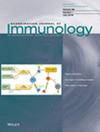使用GeoMx系统对人体皮肤免疫细胞进行高复合体分析的方法
IF 1.6
4区 医学
Q2 IMMUNOLOGY
引用次数: 0
摘要
皮肤中的特异性T细胞群已被证明是几种皮肤病的重要疾病驱动因素。由于独特的皮肤结构,这些细胞不是在结构上聚集在一起,而是分散地分布在表皮上。在组织破坏和分离后,只有大约10%的皮肤T细胞被恢复,任何体外扩增都可能改变它们的真实表型。Nanostring GeoMx系统的开发是为了解决组织空间背景下的细胞表型和蛋白质表达。为此,感兴趣区域(ROI)必须超过一定的区域阈值(通常为直径100 μm),以产生足够的信噪比。在这里,我们提出了一种方法,允许在皮肤内汇集许多较小的roi,使T细胞和黑素细胞表型化。使用GeoMx系统和几个免疫分析面板分析了健康个体和白癜风患者的皮肤样本。通过汇集较小的roi并将其作为单个组进行分析,可以获得足够的信噪比。虽然这阻止了空间分析,但这种方法允许在其生理环境背景下对细胞作为一个群体进行详细分析,从而有可能研究不同组织室中罕见细胞的原位表型。本文章由计算机程序翻译,如有差异,请以英文原文为准。
Method for high‐plex analysis of immune cells in human skin using the GeoMx system
Abstract Specific T cell populations in the skin have been demonstrated as important disease drivers in several dermatoses. Due to the unique skin architecture, these cells are not grouped together in structures but dispersedly spread out throughout the epidermis. Following tissue disruption and isolation, only about 10% of skin T cells are recovered and any in vitro expansion may alter their bona fide phenotype. The Nanostring GeoMx system was developed to address cellular phenotype and protein expression in a tissue spatial context. To do so, regions of interest (ROI) must exceed a certain area threshold (usually 100 μm in diameter) to generate a sufficient signal‐to‐noise ratio. Here, we present an approach that allows for the pooling of numerous smaller ROIs within the skin, enabling T cell and melanocyte phenotyping. Skin samples from healthy individuals and vitiligo patients were analysed using the GeoMx system and several immune profiling panels. A sufficient signal‐to‐noise ratio was achieved by pooling smaller ROIs and analysing them as a single group. While this prevents spatial analysis, this method allows for detailed analysis of cells as a population in the context of their physiological environment, making it possible to investigate in situ phenotype of rare cells in different tissue compartments.
求助全文
通过发布文献求助,成功后即可免费获取论文全文。
去求助
来源期刊
CiteScore
7.70
自引率
5.40%
发文量
109
审稿时长
1 months
期刊介绍:
This peer-reviewed international journal publishes original articles and reviews on all aspects of basic, translational and clinical immunology. The journal aims to provide high quality service to authors, and high quality articles for readers.
The journal accepts for publication material from investigators all over the world, which makes a significant contribution to basic, translational and clinical immunology.

 求助内容:
求助内容: 应助结果提醒方式:
应助结果提醒方式:


